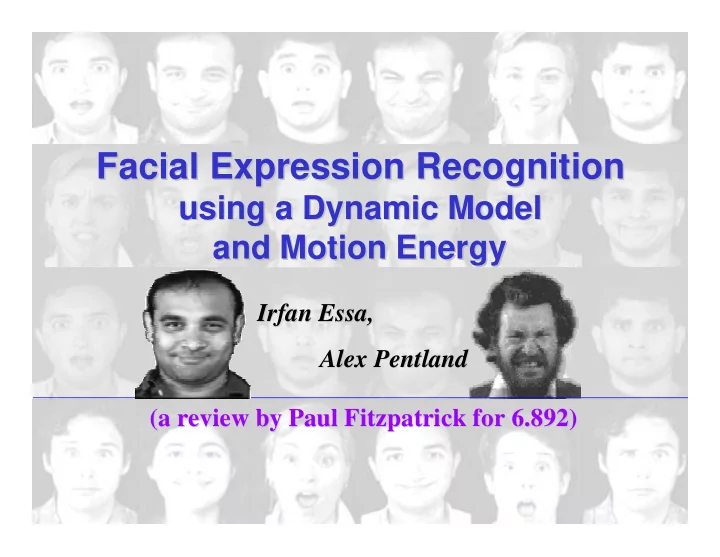

Facial Expression Recognition Facial Expression Recognition using a Dynamic Model using a Dynamic Model and Motion Energy and Motion Energy Irfan Essa, Essa, Irfan Alex Pentland Alex Pentland (a review by Paul Fitzpatrick for 6.892) (a review by Paul Fitzpatrick for 6.892)
Overview � Want to categorize facial motion � Existing coding schemes not suitable – Oriented towards static expressions – Designed for human use � Build better coding scheme – More detailed, sensitive to dynamics � Categorize using templates constructed from examples of expression changes – Facial muscle actuation templates – Motion energy templates
Motivation Motivation Motivation Facial Action Coding System � FACS allows psychologists code expression from static facial “mug-shots” � Facial configuration = combination of “action units”
Motivation Motivation Motivation Problems with action units � Spatially localized – Real expressions are rarely local � Poor time coding – Either no temporal coding, or heuristic – Co-articulation effects not represented
Motivation Motivation Motivation Solution: add detail � Represent time course of all muscle activations during expression � For recognition, match against templates derived from example activation histories � To estimate muscle activation: – Register image of face with canonical mesh – Through mesh, locate muscle attachments on face – Estimate muscle activation from optic flow – Apply muscle activation to face model to generate “corrected” motion field, also used for recognition
Modeling Modeling Modeling Registering image with mesh � Find eyes, nose, mouth � Warp on to generic face mesh � Use mesh to pick out further features on face
Modeling Modeling Modeling Registering mesh with muscles � Once face is registered with mesh, can relate to muscle attachments � 36 muscles modeled; 80 face regions
Modeling Modeling Modeling Parameterize face motion � Use continuous time Kalman filter to estimate: – Shape parameters: mesh positions, velocities, etc. – Control parameters: time course of muscle activation
Modeling Modeling Modeling Driven by optic flow � Computed using coarse to fine methods � Use flow to estimate muscle actuation � Then use muscle actuation to generate flow on model
Analysis Analysis Analysis Spatial patterning � Can capture simultaneous motion across the entire face � Can represent the detailed time course of muscle activation � Both are important for typical expressions
Analysis Analysis Analysis Temporal patterning � Application/release/relax structure – not a ramp � Co-articulation effects present a(e (c-bx) -1) a(e bx -1) Second Peak
Recognition Recognition Recognition Peak muscle actuation templates � Normalize time period of expression � For each muscle, measure peak value over application and release � Use result as template for recognition – Normalizes out time course, doesn’t actually Peak muscle actuations during smile use it for recognition? (dotted line is template)
Recognition Recognition Recognition Peak muscle actuation templates � Randomly pick two subjects making expression, combine to form template � Match against template using normalized dot product Templates Peak muscle actuations for 5 subjects
Recognition Recognition Recognition Motion energy templates � Use motion field on face High model, not on original image � Build template representing how much movement there is at each location on the face – Again, summarizes over time course, rather than representing it in detail Low – But does represent some Motion energy template temporal properties for smile
Recognition Recognition Recognition Motion energy templates � Randomly pick two subjects making expression, combine to form template � Match against template using Euclidean distance High Smile Surprise Anger Disgust Raise brow Low
Results Results Results Data acquisition � Video sequences of 20 subjects making 5 expressions – smile, surprise, anger, disgust, raise brow � Omitted hard-to-evoke expressions of sadness, fear � Test set: 52 sequences across 8 subjects
Results Results Results Data acquisition
Results Results Results Using peak muscle actuation � Comparison of peak muscle actuation against templates across entire database � 1.0 indicates complete similarity
Results Results Results Using peak muscle actuation � Actual results for classification � One misclassification over 51 sequences
Results Results Results Using motion energy templates � Comparison of motion energy against templates across entire database � Low scores indicate greater similarity
Results Results Results Using motion energy templates � Actual results for classification � One misclassification over 49 sequences
Comments Comments Comments Small test set � Test set is a little small to judge performance � Simple simulation of the motion energy classifier using their tables of means and std. deviations shows: – Large variation in results for their sample size – Results are worse than test data would suggest – Example: anger classification for large sample size has accuracy of 67%, as opposed to 90% � Simulation based on false Gaussian, uncorrelated assumption (and means, deviations derived from small data set!)
Comments Comments Comments Naïve simulated results Smile 90.7% 1.4% 2.0% 19.4% 0.0% Surprise 0.0% 64.8% 9.0% 0.1% 0.0% Anger 0.0% 18.2% 67.1% 3.8% 9.9% Disgust 9.3% 13.1% 21.4% 76.7% 0.0% Raise brow 0.0% 2.4% 0.5% 0.0% 90.1% Overall success rate: 78% (versus 98%)
Comments Comments Comments Motion estimation vs. categorization � The authors’ formulation allows detailed prior knowledge of the physics of the face to be brought to bear on motion estimation � The categorization component of the paper seems a little primitive in comparison � The template-matching the authors use is: – Sensitive to irrelevant variation (facial asymmetry, intensity of action) – Does not fully use the time course data they have been so careful to collect
Conclusion Conclusion Conclusion Video, gratuitous image of Trevor ’95 paper – what came next? Real-time version with Trevor
Recommend
More recommend